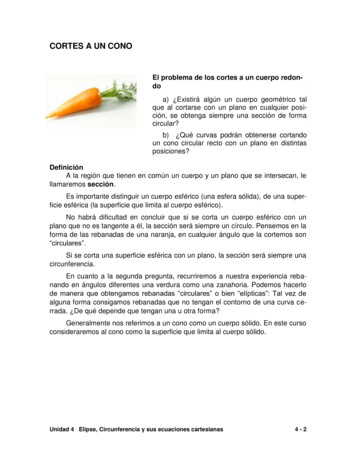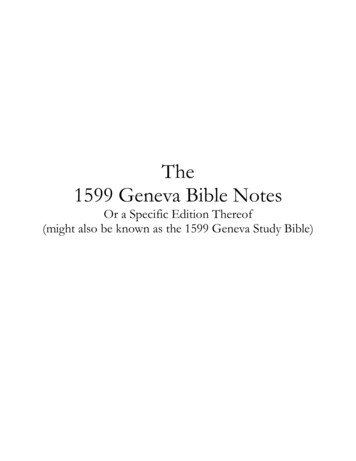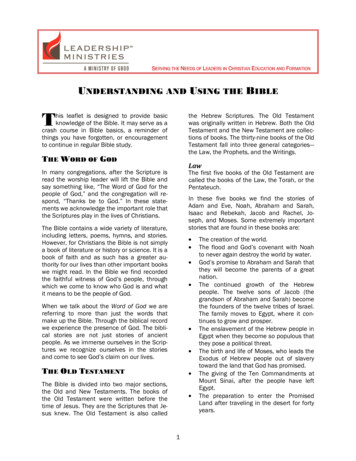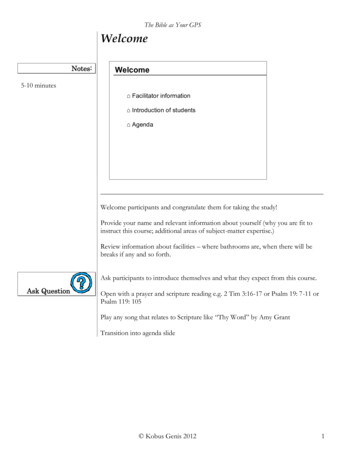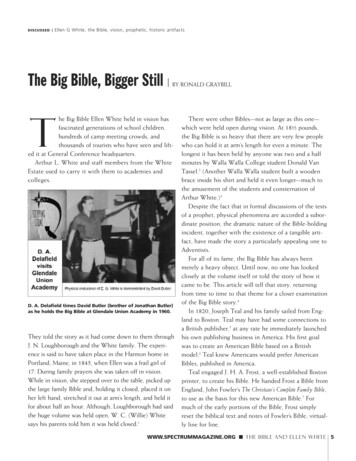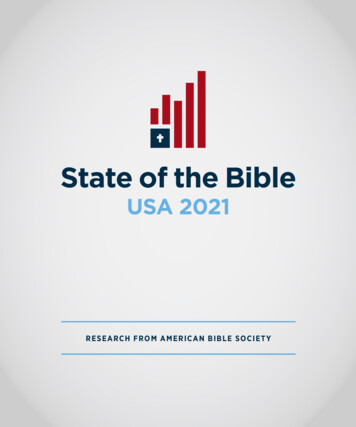
Transcription
Notes onJohn2 0 2 2 E d i t i o nDr. Thomas L. ConstableWRITERThe writer of this Gospel did not identify himself as such in the text. Thisis true of all the Gospel evangelists. Nevertheless there is evidence withinthis Gospel, as well as in the writings of the church fathers, that the writerwas the Apostle John.1The internal evidence from the Gospel itself is as follows: In 21:24, thewriter of "these things" (i.e., the whole Gospel) was the same person asthe "disciple whom Jesus loved" (21:7).2 That disciple was one of the sevendisciples mentioned in 21:2. He was also the disciple who sat beside Jesusin the upper room when He instituted the Lord's Supper and the disciple towhom Peter motioned (13:23-24). This means that he was one of theTwelve, since only they were present in the upper room (Mark 14:17; Luke22:14). The "disciple whom Jesus loved" was also one of the inner circleof three disciples, namely, Peter, James, and John (Mark 5:37-38; 9:2-3;14:33; John 20:2-10).James died in the early history of the church, probably in the early 40s(Acts 12:2). There is good evidence that whoever wrote this Gospel did soafter then. The writer was also not Peter (21:20-24). This evidence pointsto John as the "disciple whom Jesus loved," who was also the writer of thisGospel. The writer claimed to have seen Jesus' glory (1:14; cf. 1:1-4),which John did at the Transfiguration. There are several Johns in the NewTestament. This John was one of Zebedee's sons, who was a fishermanbefore Jesus called him to leave his nets and follow Him.igw1See Marcus Dods, "The Gospel According to John," in The Expositor's GreekTestament, 1:655-78; W. Graham Scroggie, A Guide to the Gospels, pp. 135-38.2Quotations from the English Bible in these notes are from the New American StandardBible (NASB), 2020 edition, unless otherwise indicated.Copyright Ó 2022 by Thomas L. Constable
Dr. Constable's Notes on John22022 Edition"To a certain extent each of the Gospels reflects thepersonality of its author, but in none of them is there a moredistinctive individuality manifested than in John."1In the article just quoted, the writer showed how John projected hispersonality into his writing of this Gospel.The external evidence also points to the Johannine authorship of the fourthGospel. Irenaeus, the bishop of Lyons (ca. A.D. 130-200), wrote that hehad heard Polycarp (ca. A.D. 69-155), who was a disciple of John. It wasapparently from Polycarp that Irenaeus learned that, "John, the disciple ofthe Lord, who also had leaned upon His breast, had himself published aGospel during his residence in Ephesus in Asia."2 Other later church fatherssupported this tradition, including Theophilus of Antioch (ca. A.D. 180),Clement of Alexandria, Tertullian of Carthage, and Tatian.3 Eusebius (fourthcentury) also specifically mentioned that Matthew and John, among theapostles, wrote the Gospels that bear their names.4Some scholars have rejected this seemingly clear evidence and haverefused to accept Johannine authorship. This criticism generally comesfrom those who hold a lower view of Scripture. Answering their objectionslies outside the purpose of these notes.5PLACE OF WRITINGEusebius also wrote that John ministered to the church in Ephesus, whichPaul had founded (Acts 19:1-20), for many years.6 The Isle of Patmos,where John spent some time in exile, is close to Ephesus (cf. Rev. 1:9-11).1MerrillC. Tenney, "The Author's Testimony to Himself," Bibliotheca Sacra 120:479 (JulySeptember 1963):223.2Irenaeus, Against Heresies, 3:1.3See Edwin A. Blum, "John," in The Bible Knowledge Commentary: New Testament, p. 267;Merrill C. Tenney, "John," in John-Acts, vol. 9 of The Expositor's Bible Commentary, pp. 56; and George R. Beasley-Murray, John, pp. lxvi-lxxv.4Eusebius, The Ecclesiastical History of Eusebius Pamphilus, 3:24:3-8.5For treatment of these views, see Donald A. Carson, The Gospel According to John, pp.68-81, and books on Bible Introduction. For a more complete discussion of authorship,see B. F. Westcott, The Gospel According to St. John: The Authorised Version withIntroduction and Notes, pp. v-xxxv.6Eusebius, 3:24:1.
2022 EditionDr. Constable's Notes on John3Eusebius wrote that John composed his Gospel when he was at Ephesus.1During the first century, that city was one of the largest centers ofChristian activity in the Gentile world. Antioch of Syria and Alexandria inEgypt have been suggested as sites of composition, but they do not haveas good support as Ephesus does.2DATEA few scholars believe that John could have written this book as early asA.D. 45, the date when Saul of Tarsus' persecutions drove many Christiansout of Jerusalem (cf. Acts 8:1-4).3 There are two main problems with suchan early date: First, John seems to have assumed that the Synoptic Gospelswere available to the Christian public. There is some doubt about this, sinceit assumes an assumption, but most scholars believe, on the basis ofcontent, that John selected his material to supplement the material in theSynoptics.4 This would put the fourth Gospel later than the Synoptics.Second, according to early church tradition the Apostle John lived long inthe first century. This would make a later date possible even though it doesnot prove a later date. Some students of the book believe that John 21:1822 implies that Peter would die before John did, and Peter died about A.D.67. In general, most authorities reject a date this early for these and otherreasons.Some conservatives date the Gospel slightly before A.D. 70, because Johndescribed the land of Israel and Jerusalem as they were before the Romandestruction (cf. 5:2).5 This may be a weak argument, since John frequentlyused the Greek present tense to describe things in the past. Some whohold this date note the absence of any reference to Jerusalem's destructionin John. However, there could have been many reasons that John chose notto mention the destruction of Jerusalem if he wrote after that event. A1Ibid.,2For3:24:3-8.discussion, see Leon Morris, The Gospel According to John: Revised Edition, pp. 54-55.3E.g., Edwin R. Goodenough, "John: A Primitive Gospel," Journal of Biblical Literature 64(1945): Part 2:145-82.4See Kenneth G. Hanna, From Gospels to Glory, pp. 93-94.5E.g., Morris, p. 30; Robert N. Wilkin, "The Gospel According to John," in The Grace NewTestament Commentary, 1:357-58; Daniel B. Wallace, Greek Grammar Beyond the Basics:An Exegetical Syntax of the New Testament, pp. 531, 177-205.
4Dr. Constable's Notes on John2022 Editiondate of writing before the destruction of Jerusalem is also a minorityopinion among scholars.Many scholars believe that John wrote his Gospel between A.D. 85 and 95,or close to A.D. 100.1 Early church tradition was that John wrote it whenhe was an older man. Moreover, even the early Christians regarded this asthe fourth Gospel, and they believed that John wrote it after the Synoptics.It is not clear if John had access to the Synoptic Gospels. He did not quotefrom any of them. However, his choice of material for his own Gospelsuggests that he had probably read them and chose to include othermaterial from Jesus' ministry in his account in order to supplement them.2The latest possible date would be about A.D. 100, although some moreliberal scholars date this Gospel in the second century. The Egertonpapyrus, which dates from early in the second century, containsunmistakable allusions to John's Gospel.3 This seems to rule out a secondcentury date.It seems impossible to identify the precise date of writing, as evidenced bythe difference of opinion that exists between excellent scholars. However,a date sometime between A.D. 65 and 95 is probable. I favor a date in the90s.CHARACTERISTIC FEATURES AND PURPOSEJohn's presentation of Jesus in his Gospel has been a problem to manymodern students of the New Testament. Some regard it as the greatestproblem in current New Testament studies.4 Compared to the Synoptics,which present Jesus as a historical figure, as John did, John also stressedthe deity of Jesus strongly. Darrell Bock described this difference as the1E.g.,Westcott, p. xl; William Barclay, The Gospel of John, 1:xxi; A. T. Robertson, WordPictures in the New Testament, 5:1; Everett F. Harrison, "The Gospel According to John,"in The Wycliffe Bible Commentary, p. 1072; Tenney, "John," p. 9; Blum, p. 268; Carson,p. 82; and Mark L. Bailey, "John," in The New Testament Explorer, p. 154.2R. V. G. Tasker, The Gospel According to St. John: An Introduction and Commentary, p.32.3Tenney, "John," p. 9; Carson, p. 82. See Jack Finegan, Light from the Ancient Past, pp.386-92, for more information about papyrus, leather, parchment, and vellum as writingmaterials.4E.g., Blum, p. 268.
2022 EditionDr. Constable's Notes on John5Synoptics viewing Jesus from the earth up, and John viewing Jesus fromheaven down.1 Obviously the Synoptics present Jesus as God also, but theemphasis in the fourth Gospel is more strongly on Jesus' full deity. Thisemphasis runs from the beginning, with the Word becoming flesh (1:1, 14),to the end, where Thomas confesses Jesus as his Lord and "God" (20:28).John's purpose statement (20:30-31) explains why he stressed Jesus'deity: It was so his readers would believe that He is the Christ, the Son ofGod, and thereby have eternal life.The key word in the book is the verb believe (Gr. pisteuo), which appears98 times. The noun form of the word (Gr. pistis, faith) does not occur atall. This phenomenon shows that John wanted to emphasize the importanceof active, vital trust in Jesus. Other key words are witness, love, abide, theCounselor (i.e., the Holy Spirit), light, life, darkness, Word, glorify, true, andreal.2 These words identify important themes in the Gospel.John's unique purpose accounted for his selection of material, as was trueof every biblical writer. He omitted Jesus' genealogy, birth, baptism,temptation, exorcizing demons, parables, transfiguration, institution of theLord's Supper, agony in Gethsemane, and ascension. He focused on Jesus'ministry in Jerusalem, the Jewish feasts, Jesus' private conversations withindividuals, and His preparation of His disciples for what lay ahead of them.John selected seven signs or miracles that demonstrate that Jesus was thedivine Messiah who was promised in the Old Testament (chs. 2—12).3 Healso recorded the discourses that Jesus gave following these signs thatexplained their significance. In addition, he featured Jesus' claims thatoccur in the seven unique "I am" statements (6:35; 8:12; 10:7, 9, 11, 14;11:25; 14:6; 15:1, 5).4About 93 percent of the material in John's Gospel does not appear in theSynoptics.5 This fact illustrates the uniqueness of this Gospel compared tothe other three, and it explains why they are called "Synoptic" and John is1DarrellL. Bock, Jesus according to Scripture, p. 24."John," p. 12; Wilkin, 1:358.3J. Sidlow Baxter, Explore the Book, 5:292, believed that John included 8 sign miracles,and J. Vernon McGee, Thru the Bible with J. Vernon McGee, 4:365, believed that heincluded 11.4See Bruce R. Reichenback, "The Theological Significance of Sevens in John," BibliothecaSacra 177:707 (July-September 2020):286-307.5Blum, p. 269. See Baxter, 5:271-85, for his consecutive view of the Lord's ministry.2Tenney,
Dr. Constable's Notes on John62022 Editionnot. For example, John recorded no story parables of Jesus, though he didinclude many extended discourses and personal conversations that theother Gospel evangelists omitted." it is undeniable that the discourses of the Lord which arepeculiar to St John's Gospel are, for the most part, very briefsummaries of elaborate discussions and expositions in relationto central topics of faith."1"Its [this Gospel's] aim is, not to give us what Jesus said like anewspaper report, but to give us what Jesus meant."2All four Gospels are quite similar, and the three Synoptics are even moresimilar, though each Gospel has its own distinctive features. John, on theother hand, is considerably different from the others. Specifically, itemphasizes Jesus' deity more strongly than the others do. It is, I believe,impossible to determine for certain whether or not John used or even knewof the Synoptic Gospels.3 I suspect that he did.Another difference between the Synoptics and the fourth Gospel is thewriters' view of eschatology (the end times). They all share the same basicview, namely, that the Jews' rejection of their Messiah resulted in thepostponement (or delay) of the earthly kingdom of Messiah. However, theSynoptic writers focused on the future aspects of eschatology more thanJohn did. He put more emphasis on the present or realized aspects ofeschatology.John stressed the aspects of messianic kingdom life that Christianscurrently enjoy as benefits of the New Covenant, which Jesus inauguratedwith His death. These include the Holy Spirit's ministries of indwelling andilluminating the believer. Such a shift in emphasis is understandable if Johnwrote later than the other Gospel evangelists. By then it was clear that Godhad postponed (delayed) the earthly kingdom, and believers' interest wasmore on life in the church than it was on life in the future earthly kingdom(cf. chs. 13—17).1Westcott,p. lvii.1:xxxix.3For discussion of this issue, see Morris, pp. 43-45, and James D. Dvorak, "The RelationshipBetween John and the Synoptic Gospels," Journal of the Evangelical Theological Society41:2 (June 1998):201-13.2Barclay,
2022 EditionDr. Constable's Notes on John7"It is quite possible that one of John's aims was to combatfalse teaching of a docetic type. The Docetists held that theChrist never became incarnate; everything was 'seeming.' Thatthe docetic heresy did not appear in the first century seemsclear, but certain elements that later were to be embodied inthis heresy seem to have been quite early."1"A heresy is seldom a complete lie and a complete untruth; aheresy usually results when one side, one part, one facet ofthe truth is unduly emphasised [sic]."2The Greek word dokein, meaning "to seem," is the origin of the name ofthis heresy."We have suggested that the Fourth Gospel was addressed totwo groups within the Johannine community, each of whichrepresented an extreme interpretation of the nature of Jesus:one which did not accept him as God, and the other which didnot accept him as man (see the introduction, xxiii; alsoSmalley, John, 145-48). The perfectly balanced christology ofthe Fourth Gospel was intended, we believe, to provide aresolution of this theological crisis: to remind the ex-Jewishmembers of the group, with their strong emphasis on thehumanity of Jesus, that the Christ was divine; and to insist, forthe benefit of the ex-pagan members (with their doceticoutlook), that Jesus was truly human."3The context of Jesus' ministry accounts for the strong Jewish flavor thatmarks all four Gospels. Yet John's Gospel is more theological andcosmopolitan and less Jewish than the others."It has a wider appeal to growing Christian experience andto an enlarging Gentile constituency than the others. TheSynoptics present him for a generation in process of beingevangelized; John presents him as the Lord of the maturingand questioning believer."41Morris,p. 31.1:xxvi.3Stephen S. Smalley, 1, 2, 3 John, p. 101.4Tenney, "John," p. 4. Paragraph division omitted.2Barclay,
Dr. Constable's Notes on John82022 EditionAs a piece of literature, John's Gospel has a symphonic structure. Baxtercalled this a style of "recurrent ideas."1 This structural style alsocharacterizes John's first epistle."A symphony is a musical composition having severalmovements related in subject, but varying in form andexecution. It usually begins with a dominant theme, into whichvariations are introduced at intervals. The variations seem tobe developed independently, but as the music is played, theymodulate into each other until finally all are brought to aclimax. The apparent disunity is really part of a design which isnot evident at first, but which appears in the progress of thecomposition."2Tenney identified the major themes as the signs, the sonship andmessiahship of Christ, and eternal life. Tasker described the fourth Gospelas "the simplest and yet the most profound of the Christian Gospels."3"The test of time has given the palm to the Fourth Gospel overall the books of the world. If Luke's Gospel is the mostbeautiful, John's Gospel is supreme in its height and depth andreach of thought. The picture of Christ here given is the onethat has captured the mind and heart of mankind. Thelanguage of the Fourth Gospel has the clarity of a spring, butwe are not able to sound the bottom of the depths. Lucidityand profundity challenge and charm us as we linger over it."4Baxter believed that the structure of John corresponds to the furniture ofthe Old Testament tabernacle.5Let me encourage you to read this Gospel through at one sitting sometime,if you have not already done so. I remember the first time that I did, whenI was a teenager. The book made a profound impression on me. Read this1Baxter,5:289.C. Tenney, "The Symphonic Structure of John," Bibliotheca Sacra 120:478 (AprilJune 1963):117-18.3Tasker, p. 10.4Robertson, 5:ix.5See Baxter, 5:295-98, for further explanation.2Merrill
2022 EditionDr. Constable's Notes on John9way, the impact of Jesus' life is tremendous. One can hardly escape theconviction that Jesus is the Christ.ORIGINAL RECIPIENTSWhen one reads this Gospel one can get the impression that John wroteprimarily for Christians. This impression may seem to contradict John'sstated purpose for writing (20:30-31). One writer wrote that this is theonly book in the Bible written to unbelievers.1 Probably John wrote both toconvince unbelievers that Jesus was the Son of God, and at the same timehe wrote to give Christians—especially those who faced persecution—confidence in their Savior.2 The word believe in 20:31 may be in the Greekpresent tense in order to imply that Christian readers should continuebelieving. Or it could be in the Greek aorist tense in order to suggest thatpagan readers should believe initially.An evangelistic purpose does not exclude an edification purpose. Indeed,all 66 books of the Bible have edifying value for God's people (2 Tim. 3:1617). John's purpose for unbelievers was that they might obtain eternal life,and his purpose for believers was that they might experience abundanteternal life (10:10). Though most students of this Gospel have concludedthat John's purpose in writing was primarily evangelistic, some have feltthat it was primarily for the growth of believers.3John explained Jewish customs, translated Jewish names, and locatedJewish sites. These facts suggest that he was writing for Gentile readerswho lived primarily outside the Jews' homeland. Furthermore, the prologueseems addressed to readers who thought in Greek terms. John's inclusionof the Greeks, who showed interest in seeing Jesus (12:20-22), may alsosuggest that he wrote with them in view. Because of John's generalpurposes, it seems best to conclude that the original readers were primarilyGentile Christians and Gentile unbelievers. Carson argued that John'spurpose was specifically to evangelize Jews and Jewish proselytes.41Wilkin,1:357.Beasley-Murray, p. lxxxix.3E.g., McGee, 4:364.4Carson, pp. 87-95.2Cf.
Dr. Constable's Notes on John102022 Edition"By the use of personal reminiscences interpreted in the lightof a long life of devotion to Christ and by numerous episodesthat generally had not been used in the Gospel tradition,whether written or oral, John created a new and differentapproach to understanding Jesus' person. John's readers wereprimarily second-generation Christians he was familiar with andto whom he seemed patriarchal."1The writer did not indicate the geographical location of the originalrecipients of his Gospel. This was undoubtedly intentional since themessage of John has universal appeal. Perhaps its first readers lived in theRoman province of Asia, the capital of which was Ephesus, where John livedduring the latter part of his life.2SUMMARY OF GOSPEL LINEI.Prologue 1:1-18A.B.1Tenney,The pre-incarnate Word 1:1-5The witness of John the Baptist 1:6-8"John," p. 10.Donald A. Carson and Douglas J. Moo, An Introduction to the New Testament, pp.225-84, for extensive discussion of introductory matters.2See
2022 EditionC.D.II.Dr. Constable's Notes on John11The appearance of the Light 1:9-13The incarnation of the Word 1:14-18Jesus' public ministry 1:19—12:50A.The prelude to Jesus' public ministry 1:19-511.2.3.4.B.Jesus' early Galilean ministry 2:1-121.2.C.The interview with the Samaritan woman 4:1-26Jesus' explanation of evangelistic ministry 4:27-38The response to Jesus in Samaria 4:39-42Jesus' resumption of His Galilean ministry 4:43-541.2.F.The first cleansing of the temple 2:13-22Initial response to Jesus in Jerusalem 2:23-25Jesus' conversation with Nicodemus 3:1-21John the Baptist's reaction to Jesus' ministry 3:22-30The explanation of Jesus' preeminence 3:31-36Jesus' ministry in Samaria 4:1-421.2.3.E.The first sign: changing water into wine 2:1-11Jesus' initial stay in Capernaum 2:12Jesus' first visit to Jerusalem 2:13—3:361.2.3.4.5.D.John the Baptist's veiled testimony to Jesus 1:19-28John the Baptist's open identification of Jesus 1:29-34The response to John the Baptist's witness 1:35-42The witness of Andrew and Philip 1:43-51Jesus' return to Galilee 4:43-45The second sign: healing the official's son 4:46-54Jesus' second visit to Jerusalem ch. 51.2.3.4.TheTheTheThethird sign: healing the paralytic 5:1-9antagonism of the Jewish authorities 5:10-18Son's equality with the Father 5:19-29Father's witness to the Son 5:30-47
Dr. Constable's Notes on John12G.Jesus' later Galilean ministry 6:1—7:91.2.3.4.H.fourth sign: feeding the 5,000 6:1-15fifth sign: walking on the water 6:16-21bread of life discourse 6:22-59responses to the bread of life discourse 6:60—7:9The controversy surrounding Jesus 7:10-13Jesus' ministry at the Feast of Tabernacles 7:14-44The unbelief of the Jewish leaders 7:45-52The woman caught in adultery 7:53—8:11The light of the world discourse 8:12-59The sixth sign: healing a man born blind ch. 9The good shepherd discourse 10:1-21The confrontation at the Feast of Dedication 10:22-42The conclusion of Jesus' public ministry chs. 11—121.2.3.4.5.6.7.III.TheTheTheTheJesus' third visit to Jerusalem 7:10—10:421.2.3.4.5.6.7.8.I.2022 EditionThe seventh sign: raising Lazarus 11:1-44The responses to the raising of Lazarus 11:45-57Mary's anointing of Jesus 12:1-8The official antagonism toward Lazarus 12:9-11Jesus' triumphal entry 12:12-19Jesus' announcement of His death 12:20-36The unbelief of Israel 12:37-50Jesus' private ministry chs. 13—17A.The Last Supper 13:1-301.2.B.Jesus' washing of the disciples' feet 13:1-20Jesus' announcement of His betrayal 13:21-30The Upper Room Discourse 13:31—16:331.2.3.Jesus' announcement and command 13:31-35Peter's question about Jesus' departure and Jesus' reply13:36-38Jesus' comforting revelation in view of His departure14:1-24
2022 Edition4.5.6.7.8.C.13Jesus' promise of future understanding 14:25-31The importance of abiding in Jesus 15:1-16The warning about opposition from the world 15:17-27The clarification of the future 16:1-24The clarification of Jesus' destination 16:25-33Jesus' high priestly prayer ch. 171.2.3.IV.Dr. Constable's Notes on JohnJesus' requests for Himself 17:1-5Jesus' requests for the Eleven 17:6-19Jesus' requests for future believers 17:20-26Jesus' passion ministry chs. 18—20A.B.Jesus' presentation of Himself to His enemies 18:1-11Jesus' religious trial 18:12-271.2.3.4.C.Jesus' civil trial 18:28—19:161.2.3.4.D.TheTheTheTheJews' charge against Jesus 18:28-32question of Jesus' kingship 18:33-38aJews' request for Barabbas 18:38b-40sentencing of Jesus 19:1-16Jesus' crucifixion 19:17-301.2.3.4.5.6.E.The arrest of Jesus and the identification of the highpriests 18:12-14The entrance of two disciples into the high priest'scourtyard and Peter's first denial 18:15-18Annas' interrogation of Jesus 18:19-24Peter's second and third denials of Jesus 18:25-27Jesus' journey to Golgotha 19:17The men crucified with Jesus 19:18The inscription over Jesus' cross 19:19-22The distribution of Jesus' garments 19:23-24Jesus' provision for His mother 19:25-27The death of Jesus 19:28-30The treatment of Jesus' body 19:31-421.The removal of Jesus' body from the cross 19:31-37
Dr. Constable's Notes on John142.F.4.V.The burial of Jesus 19:38-42Jesus' resurrection 20:1-291.2.3.G.2022 EditionThe discovery of Peter and John 20:1-10The discovery of Mary Magdalene 20:11-18The appearance to the Eleven minus Thomas on Easterevening 20:19-23The transformed faith of Thomas 20:24-29The purpose of this Gospel 20:30-31Epilogue ch. 21A.B.C.Jesus' appearance to seven disciples in Galilee 21:1-14Jesus' teachings about motivation for service 21:15-23The writer's postscript 21:24-25MESSAGEIn one sense, the Gospel of John is more profound than the Synoptics. It isthe most difficult Gospel for most Bible expositors to preach and teach forreasons that become evident as one studies it. For my first experienceteaching a series of home Bible studies, I chose this book, because I thoughtit would not be too difficult. I soon discovered that understanding andcommunicating much of what John wrote was not easy. In another sense,however, the fourth Gospel is the easiest Gospel to understand. Leon Morriswrote that it is a pool in which a child can wade and an elephant can swim.1It is both simple and profound. It clarifies some things that the Synopticsleave as mysteries.What are these mysteries? Matthew presents Jesus as the King, but it doesnot articulate the reason for Jesus' great authority—but John does. Markpresents Jesus as the Servant, but it does not account for His depth ofconsecration to God—but John does. Luke presents Jesus as the perfectMan, but it does not explain His uniqueness from the rest of humankind—but John does.1Morris,p. 3.
2022 EditionDr. Constable's Notes on John15The Gospel of John reveals answers to the mysteries about Jesus that theSynoptics leave hidden. It is, therefore, an apocalypse, an unveiling, similarto the Book of Revelation in this respect. The Book of Revelation is theclimax of biblical Christology. The Gospel of John plays that part among theGospels (cf. Deuteronomy in the Pentateuch). It is a revelation of theperson of Jesus Christ more than any of the others. John told us that itwould be this in his prologue (1:1-18). Though it is an apocalypse in thissense, it does not contain apocalyptic content, which refers to a particularliterary genre describing cataclysmic end times events.The statement of the message of this Gospel occurs in 1:18: "No one hasseen God at any time; God the only Son, who is in the arms of the Father,He has explained Him." John claimed that Jesus, the Son of God, was theexplanation of God the Father. This Gospel presents Jesus as the One whomanifested God to humankind. It then stresses the revelation of the truthabout God.People have constantly sought to represent God in some way. We want toknow what God is like. Ideas about God that do not come from therevelation of Himself in Jesus Christ are usually wrong, even idolatrous.They create a false view of God. Typically human beings without divinerevelation have imagined God as being an immense version of themselves,a projection of human personality into cosmic proportions. God's revelationof Himself, however, involved the limitation of Himself to humanity, theexact opposite approach. This is what God did in the Incarnation. God'srevelations are often the exact opposite of what one would expect.John presented Jesus as the Son of God. He wanted his readers to viewJesus and to see God. In the tears of Jesus we should see what causes Godsorrow. In the compassion of Jesus we should see how God cares for Hisown. In the anger of Jesus we should see what God hates.What do we learn about God from Jesus in John? The prologue gives us theessential answer, and the body of the book explains this answer withvarious illustrations from Jesus' ministry. The prologue tells us that Jesushas manifested the glory of God by revealing two things about Him: Hisgrace and His truth (1:14). All that Jesus revealed about God that thisGospel narrates is contractible into these two words. Notice first therevelation of grace in this Gospel:
16Dr. Constable's Notes on John2022 EditionThe Gospel of John presents God as a gracious person. Behind His graciousdealings lies a heart of love. There are probably hundreds of evidences ofGod's love resulting in gracious action in this book. Note just the evidenceof these qualities in the seven signs that John chose to record.The miracle of changing water into wine (ch. 2) shows God's concern formarital joy. The healing of the official's son (ch. 4) shows God's desire thatpeople experience family unity. The healing of the paralytic (ch. 5) showsGod's grace in providing physical restoration. The feeding of the 5,000 (ch.6) shows God's love in providing material needs. The miracle of Jesuswalking on the water (ch. 6) shows God's desire that people enjoysupernatural peace. The healing of the man born blind (ch. 9) illustratesGod's desire that we have true understanding. The raising of Lazarus (ch.11) shows God's grace in providing new life. All of these miracles arerevelations of God's love manifesting itself in gracious behavior towardpeople in their various needs. These are only the most obviousmanifestations of God's grace in this book.1This Gospel also reveals that God is a God of truth. Another one of God'sattributes that we see revealed in this Gospel lies behind the truth that wesee revealed in this Gospel. That
unmistakable allusions to John's Gospel.3 This seems to rule out a second century date. It seems impossible to identify the date of writing precisely, as evidenced by the difference of opinion that exists between excellent conservative scholars. How
